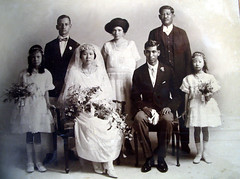 Early last year, I was blogging about my attempts at making pineapple tarts. This year, I wanted to do another batch of tarts and decided that it was a good opportunity to go back to the good old days when the family was roped in to share out the tedious work. And so I got my cousin involved with the jam and tart-making.
Early last year, I was blogging about my attempts at making pineapple tarts. This year, I wanted to do another batch of tarts and decided that it was a good opportunity to go back to the good old days when the family was roped in to share out the tedious work. And so I got my cousin involved with the jam and tart-making. This year, I had also managed to lay hands on my Grand Aunt's recipe, courtesy of her daughter. The basic ingredients were similar to those in my recipe posted up last year with one small, but critical difference - the inclusion of 3 teaspoons of lard every 250g of butter. And, she used egg yolks only instead of eggs, reserving the whites to glaze the tarts and to mix with the pineapple jam to get that nice, smooth surface.
I decided to stick to my tangy jam recipe (since I rather liked the inclusion of the pineapple juice rather than sugar to sweeten the jam). I also had problems finding zero-transfat shortening (I was not going to use lard) so we omitted that for the first batch of tarts. Anyway, we started off with the jam-making process. My dear mother was only too happy to show how dextrous she was with her knife, as she expertly removed the pineapple skin and eyes, chopped it up and readied it for the blender. We then blended the pineapple with the juice and stood over the stove for simply ages, stirring and waiting for it to reduce down, change colour from pale yellow to that wonderful orangey brown. At least we could chat a bit. Making jam alone is indeed lonely work.
The next day, I popped over to my cousin's to make the pastry (she has a better oven). Here, we had the benefit of getting assistance from her young nephews, our bakers' apprentices. I was amazed by the conscientious attitude displayed, especially by the older of the two. His task was to cut out the pineapple tarts using the cutter and the mould. It's not an easy task as the pastry mould must be pressed down just so in order to leave an imprint on the dough. The tart must also be carefully peeled away from the mould without breaking the dough. No small feat for our young apprentice to master. We completed a batch of some 100+ tarts, from our 500g of flour.
I subsequently made a second batch of tarts to finish off the jam. This time round, I got the Crisco from Phoon Huat. I also bought a plastic pineapple tart cutter/mould for our keen young apprentice chef, which he could use when his aunty makes tarts. I thought the top of the plastic cutter was less sharp than the metallic one, and so he could cut the pastry happily without inadvertently injuring himself.
So is it better with shortening, or without? My verdict: Go with the shortening - it really gives it a much better, more crumbly texture. Which makes the ingredients for the pastry as follows:
250g flour; 125g butter; 1-2 tsp of veg shortening; pinch of salt to taste; 1/2 tablespoon of sugar, 1.5 egg-yolks, water.
Rest of recipe and the process remains the same as in the earlier recipe.
















